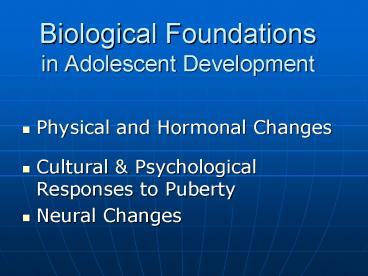Physical and Hormonal Changes - PowerPoint PPT Presentation
1 / 19
Title:
Physical and Hormonal Changes
Description:
Biological Foundations in Adolescent Development Physical and Hormonal Changes Cultural & Psychological Responses to Puberty Neural Changes Physical changes Puberty ... – PowerPoint PPT presentation
Number of Views:117
Avg rating:3.0/5.0
Title: Physical and Hormonal Changes
1
Biological Foundations in Adolescent Development
- Physical and Hormonal Changes
- Cultural Psychological Responses to Puberty
- Neural Changes
2
Physical changes
- Puberty onset of sexual maturation
- Three neuroendocrine changes
- Gonadal
- Adrenal androgens
- Growth
3
Gonadal and adrenal androgen axes
4
Gonadal (HPG) axis
Gonadotropin releasing hormone (LH, FSH are
gonadotropins) (testes or ovaries) (sex
hormones testosterone estradiol increase
dramatically -- gonadarche) (see next slide)
5
Sex Characteristics (examples)
Primary Sex Characteristics Secondary Sex Characteristics
Production of sperm (spermarche) or development of eggs Development of sex organs Pubic and axillary hair growth Skin becomes rougher oily Voice deepens Slight enlargement of breasts known as breast buds (also, in ¼ of boys)
6
Adrenal androgen (HPA) axis
(ACTH adrenocorticotropic
hormone) (e.g., testosterone) (leading to
secondary changes)
7
Growth spurts and height changes
8
Body composition changes
Given that girls naturally develop a lower
muscle-to-fat ratio than boys during puberty, why
would any culture create physical ideals that
demand thinness in females once they reach
puberty? AND what are the health implications?
9
The Order of Pubertal Events (see Table 2.2)
10
Pubertal Caveat
- Virtually all the studies considered in the order
of pubertal development have been conducted with
White adolescents in the West - Variations may exist in other groups (see p. 45
e.g., Kikuyu culture in Kenya, Chinese girls,
African-American girls and boys)
11
Earlier Puberty
Tanner Stage 2 (breast and pubic hair devt) by
age 10 in the majority of girls (68 in
Euro-American girls 95 in African-American
girls)
The downward trend in the age of menarche has
occurred in every Western country for which
records exist. Why?
12
Responses to Puberty
- Homework assignment
- Next section
- Cultural Psychological responses to puberty
13
Cultural Responses to Puberty Rituals in
Traditional Cultures
- 79 of cultures had puberty rituals for girls
- __________ (?) is the pubertal event that is most
often marked by ritual - Cultural views are mixed as to the reaction to
menstruation (see Historical Focus box in
chapter)
- 68 of cultures had puberty rituals for boys
(e.g., vision quest ) (Roots video) - Typically rituals require the young man to
display courage, strength and endurance (often
violent)
NOTE Globalization has been credited with the
decline in frequency of these rituals
14
Personal responses to puberty
- Behavior and emotions
- Problem behavior (e.g., aggression, conduct
disorder symptoms, etc.) has been attributed to
hormonal changes (but also to physical maturation
and brain changes) - Testosterone (T) can lower boys frustration
tolerance ? readiness to engage in aggression - Rapid hormonal changes are associated with
depression, but hormonal storm view is far too
simplistic. In fact - Hormonal levels account for only a tiny
percentage of the variance in adolescents
negative affect social influences account for
considerably more
15
Pubertal timing and adjustment
- There is a lot of research (which is conflicting)
on the effects of timing of physical development - Theoretically, being off-time creates more
stress and vulnerability to adjustment problems
16
Maturation - Girls
- According to Arnett, the effects of early
maturation are especially negative for girls, who
are at risk for a variety of problems - Depressed mood, Negative body image, Eating
disorders - Delinquency, Substance use, School problems,
Conflicts with parents - Caveat Early-maturing girls with no history of
behavior problems experienced fewer problems than
did girls with a history of behavior problems who
matured on time - Late maturing girls have few of the problems that
early-maturing girls have
17
Early Maturation - Boys
- The effects of early maturation are more mixed
for boys - Early maturing boys have
- More favorable body image
- Higher popularity
- Earlier involvement in substance use,
delinquency, and sex
18
Late Maturation Boys
- Late maturing boys show evidence of problems
- Compared with boys who mature on time late
maturing boys have higher rates of - Alcohol use
- Delinquency
- Lower grades in school
19
Neural changes
- New research in cognitive and affective
neuroscience (Intro to The Teenage Brain
PBS-DVD Sci American podcast on the teen brain) - Brain actively reorganizes itself cells and
connections are pruned (for efficiency) - Prefrontal cortex (planning and decision making)
undergoes a growth spurt in early A and continues
to develop throughout A - Cortical-limbic pathways (thought-emotion
connections) are slowly developing during
adolescence (e.g., research on teens difficulty
in reading emotions in peoples faces) - Implications?
- Research example -- incarcerated adolescents
displayed more impulsivity and poorer critical
thinking than age-matched students (Chretien
Persinger, 2000). - Driving and multitasking
- Much more research needed

